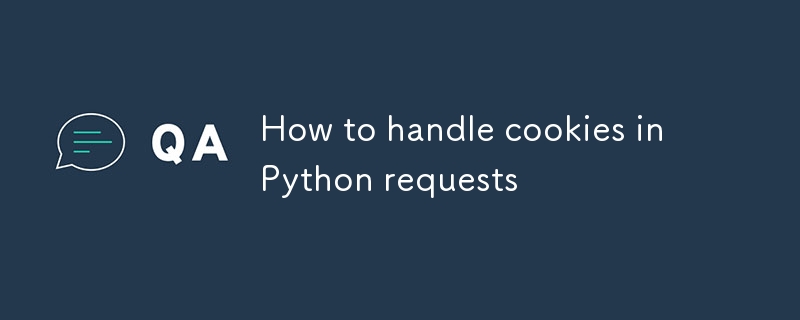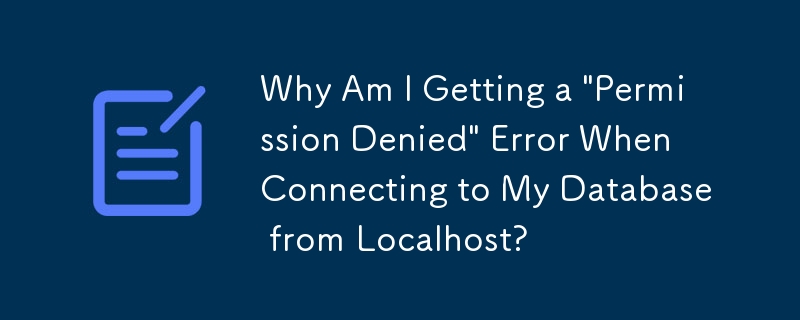Found a total of 10000 related content

How to change the session save path in PHP?
Article Introduction:To modify the session saving path of PHP, there are two methods: 1. Modify session.save_path in php.ini to implement global settings; 2. Use session_save_path() to set dynamically in the code. The first method requires editing the php.ini file, finding and modifying session.save_path to the specified directory, restarting the server after saving, and ensuring that the directory exists and has read and write permissions; the second method is suitable for a single application, using session_save_path() to set the absolute path before calling session_start(), which does not affect other projects. Notes include: Make sure the path is correct and readable
2025-07-09
comment 0
966


How can you use a database to store PHP session data?
Article Introduction:Using databases to store PHP session data can improve performance and scalability. 1) Configure MySQL to store session data: Set up the session processor in php.ini or PHP code. 2) Implement custom session processor: define open, close, read, write and other functions to interact with the database. 3) Optimization and best practices: Use indexing, caching, data compression and distributed storage to improve performance.
2025-04-27
comment 0
883

How does session hijacking work and how can you mitigate it in PHP?
Article Introduction:Session hijacking can be achieved through the following steps: 1. Obtain the session ID, 2. Use the session ID, 3. Keep the session active. The methods to prevent session hijacking in PHP include: 1. Use the session_regenerate_id() function to regenerate the session ID, 2. Store session data through the database, 3. Ensure that all session data is transmitted through HTTPS.
2025-04-06
comment 0
1650

Tutorial on saving results percentage data based on AJAX and PHP/MySQL
Article Introduction:This tutorial explains in detail how to fix database connection issues in the PHP backend to ensure that front-end AJAX requests can successfully save the score percentage data to the MySQL database. By analyzing the connection flaws of the original code, the article shows how to use mysqli to implement the correct database operation, and emphasizes security and best practices to help developers build robust web applications.
2025-09-09
comment 0
167


Use PHP to achieve cross-site password-free user authentication
Article Introduction:This article will introduce how to use PHP and Session variables to achieve cross-site password-free user authentication. The core idea is to use the main site to authenticate users and save the authentication status in the session. Other sites check session variables to determine whether the user is authenticated, thus achieving the ability to access other sites without repeated login. We will explain the implementation steps in detail and provide sample code to help you easily build a single sign-on experience similar to a Microsoft account.
2025-09-04
comment 0
409

How can you optimize PHP session performance?
Article Introduction:Methods to optimize PHP session performance include: 1. Delay session start, 2. Use database to store sessions, 3. Compress session data, 4. Manage session life cycle, and 5. Implement session sharing. These strategies can significantly improve the efficiency of applications in high concurrency environments.
2025-04-23
comment 0
557

How do you configure the session name in PHP?
Article Introduction:In PHP, you can use the session_name() function to configure the session name. The specific steps are as follows: 1. Use the session_name() function to set the session name, such as session_name("my_session"). 2. After setting the session name, call session_start() to start the session. Configuring session names can avoid session data conflicts between multiple applications and enhance security, but pay attention to the uniqueness, security, length and setting timing of session names.
2025-04-23
comment 0
587

What is a session in PHP, and why are they used?
Article Introduction:Session in PHP is a mechanism for saving user data on the server side to maintain state between multiple requests. Specifically, 1) the session is started by the session_start() function, and data is stored and read through the $_SESSION super global array; 2) the session data is stored in the server's temporary files by default, but can be optimized through database or memory storage; 3) the session can be used to realize user login status tracking and shopping cart management functions; 4) Pay attention to the secure transmission and performance optimization of the session to ensure the security and efficiency of the application.
2025-05-04
comment 0
619


How to use the Report Builder feature in Navicat?
Article Introduction:Use Navicat's ReportBuilder to create professional reports from database data without writing complex code. The steps include: 1. Ensure the database connection and select the data source; 2. Drag and drop fields in the layout editor to the Header, Detail and Footer areas and add static content; 3. Use GroupExpert to implement data grouping; 4. Format the output style, such as currency symbols, font colors and conditional formats; 5. Use the export function to save the report to PDF, Excel and other formats; 6. Save and name it clearly for subsequent use or team sharing.
2025-09-09
comment 0
366

How to get a list of all built-in PHP functions?
Article Introduction:There are three main ways to get all built-in PHP functions: 1. Check the "FunctionReference" section in the official document (php.net) to get the most authoritative and detailed function list and description; 2. Use the get_defined_functions() function in the code and access its 'internal' key to dynamically obtain all built-in function names in the current environment; 3. Run PHP scripts through the command line, use php-r to execute relevant commands and save the results to a file, which is suitable for automated processing and debugging environments.
2025-07-04
comment 0
884


How to handle cookies in Python requests
Article Introduction:The key to handling cookies in PythonRequests is to use Session objects to automatically manage cookies manually, and deal with cross-domain and expiration issues. 1. Use the Session object to automatically save and send cookies to ensure that cookies are valid throughout multiple requests; 2. You can view or manually add cookies through the .cookies attribute; 3. When encountering cross-domain or security restrictions, you need to check whether the session and cookies are saved correctly or try to extract manually; 4. In view of cookies expiration, it is recommended to encapsulate the login function and log in again if necessary to maintain the validity of the session.
2025-07-14
comment 0
1023

PHP: Handling Databases and Server-Side Logic
Article Introduction:PHP uses MySQLi and PDO extensions to interact in database operations and server-side logic processing, and processes server-side logic through functions such as session management. 1) Use MySQLi or PDO to connect to the database and execute SQL queries. 2) Handle HTTP requests and user status through session management and other functions. 3) Use transactions to ensure the atomicity of database operations. 4) Prevent SQL injection, use exception handling and closing connections for debugging. 5) Optimize performance through indexing and cache, write highly readable code and perform error handling.
2025-04-15
comment 0
1180


What is the purpose of?session_start()?in PHP?
Article Introduction:The article discusses the use and management of sessions in PHP, focusing on session_start() function, best practices for session management, and security considerations to prevent session-related vulnerabilities.
2025-03-19
comment 0
857



















